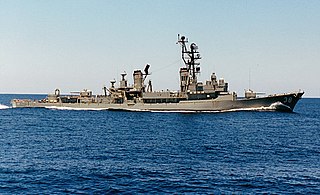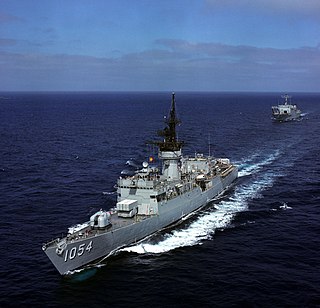Description
Brooke-class ships were nearly identical to the Garcia class, except the second 5-inch/38 caliber gun was replaced with a Tartar missile system and electronics. Brooke class ships also had the AN/SPS-52 3D air search radar instead of the two dimension AN/SPS-40 and added the AN/SPG-51 for target tracking and missile guidance. The Mk 22 single arm missile launcher was placed amidships. The magazine held 16 missiles.
FFG-1 through FFG-3 had a Westinghouse geared steam turbine while FFG-4 through FFG-6 employed a General Electric turbine. All ships had two Foster Wheeler boilers. FFG-4 through FFG-6 had an angled base of the bridge structure behind the ASROC launcher for automatic reloading.
The Brooke class was originally designed to carry the DASH drone, but were later equipped with LAMPS SH-2 Seasprite after the hangar was enlarged. [2]
Oliver Hazard Perry class systems were evaluated on Talbot including the Otobreda 76 mm gun, the AN/SQS-56 sonar and other systems. [2] [3]
Initially authorized as guided missile destroyer escorts (DEG), FFG-1 through FFG-3 were authorized in FY1962 while FFG-4 through FFG-6 were authorized in FY1963. Plans called for ten more ships to be authorized in FY1964 and possibly three more in later years, but those plans were dropped because of the $11 million higher cost of the DEG over an FF.

The RUR-5 ASROC is an all-weather, all sea-conditions anti-submarine missile system. Developed by the United States Navy in the 1950s, it was deployed in the 1960s, updated in the 1990s, and eventually installed on over 200 USN surface ships, specifically cruisers, destroyers, and frigates. The ASROC has been deployed on scores of warships of many other navies, including Canada, Germany, Italy, Japan, the Republic of China, Greece, Pakistan and others.

HMAS Newcastle, named for the city of Newcastle, New South Wales, the largest provincial city in Australia, was an Adelaide-class guided-missile frigate. The last ship of the class to be constructed, Newcastle entered service with the Royal Australian Navy in 1993. During her career, the frigate has operated as part of the INTERFET peacekeeping taskforce, served in the Persian Gulf, and responded to the 2006 Fijian coup d'état. The frigate was decommissioned on 30 June 2019 and transferred to the Chilean Navy on 15 April 2020 and renamed as Capitán Prat.

The Charles F. Adams class is a ship class of 29 guided-missile destroyers (DDG) built between 1958 and 1967. Twenty-three were built for the United States Navy, three for the Royal Australian Navy, and three for the West German Bundesmarine. The design of these ships was based on that of Forrest Sherman-class destroyers, but the Charles F. Adams class were the first class designed to serve as guided-missile destroyers. 19 feet (5.8 m) of length was added to the center of the design of the Forrest Sherman class to carry the ASROC launcher. The Charles F. Adams-class were the last steam turbine-powered destroyers built for the U.S. Navy. Starting with the succeeding Spruance-class, all U.S. Navy destroyers have been powered by gas turbines. Some of the U.S. Charles F. Adams class served during the blockade of Cuba in 1962 and during the Vietnam War; those of the Royal Australian Navy served during the Vietnam War and Gulf War.

The 46 Knox-class frigates were the largest, last, and most numerous of the US Navy's second-generation anti-submarine warfare (ASW) escorts. Originally laid down as ocean escorts, they were all redesignated as frigates on 30 June 1975, in the 1975 ship reclassification plan and their hull designation changed from 'DE' to 'FF'. The Knox class was the Navy's last destroyer-type design with a steam turbine powerplant.

Garcia-class frigates were United States Navy warships. These frigates were originally ocean escorts bearing the hull classification DE until 1975. The ships were commissioned between 1964 and 1968 and decommissioned between 1988 and 1990.

The United States Navy reclassified many of its surface vessels in 1975, changing terminology and hull classification symbols for cruisers, frigates, and ocean escorts.

Ocean escort was a type of United States Navy warship. They were an evolution of the World War II destroyer escort types. The ocean escorts were intended as convoy escorts and were designed for mobilization production in wartime or low-cost mass production in peacetime. They were commissioned from 1954 through 1974, serving in the Cold War and the Vietnam War.

HMAS Melbourne was an Adelaide-class guided-missile frigate of the Royal Australian Navy, which entered service in 1992. Melbourne has been deployed to the Persian Gulf on several occasions, and served as part of the INTERFET peacekeeping taskforce in 2000. On 26 October 2019, Melbourne was decommissioned from the RAN, subsequently being transferred to Chile. The ship was commissioned into the Chilean Navy as Almirante Latorre on 15 April 2020.

The Farragut-class destroyer was a group of 10 guided-missile destroyers built for the United States Navy (USN) during the 1950s. They were the second destroyer class to be named for Admiral David Farragut. The class is sometimes referred to as the Coontz class, since Coontz was first to be designed and built as a guided-missile ship, whereas the previous three ships were designed as all-gun units and converted later. The class was originally envisioned as a Destroyer Leader class, but was reclassified as Guided-Missile Destroyers following the 1975 ship reclassification.

The Tartar Guided Missile Fire Control System is an air defense system developed by the United States Navy to defend warships from air attack. Since its introduction the system has been improved and sold to several United States allies.

Destroyer leader (DL) was the United States Navy designation for large destroyers from 9 February 1951 through the early years of the Cold War. United States ships with hull classification symbol DL were officially frigates from 1 January 1955 until 1975. The smaller destroyer leaders were reclassified as destroyers and the larger as cruisers by the United States Navy 1975 ship reclassification so destroyer escorts could be reclassified as frigates (FF) in conformance with international usage of the term.

The Perth-class destroyers were three modified Charles F. Adams-class guided missile destroyers operated by the Royal Australian Navy (RAN). Ordered from Defoe Shipbuilding Company during 1962 and 1963, HMA Ships Perth, Hobart, and Brisbane were the first guided missiled-armed warships, and the first naval ships of United States design, to enter service with the RAN. All three ships operated during the Vietnam War, while Brisbane also participated in the Gulf War. The class was decommissioned between 1999 and 2001, with all three vessels later sunk as dive wrecks.

USS Stein (DE-1065) was a Knox-class destroyer escort, later redesignated as a frigate (FF-1065) of the United States Navy. She was named after Tony Stein, the first Marine to receive the Medal of Honor for action in the Battle of Iwo Jima.

USS Gray (FF-1054) was a United States Navy Knox-class frigate. She was named for Marine Corps Sergeant Ross F. Gray, who was a posthumous recipient of the Medal of Honor.

USS Brewton (FF-1086) is a Knox-class frigate of the United States Navy and the first ship of her name. She is currently in service with the Republic of China Navy as the ROCS Fong Yang (FFG-933).

The Audace-class destroyers were two guided missile destroyers built for the Italian Navy during the Cold War. An improvement of the Impavido class, these ships were designed for area air defence and also had a heavy gun armament. They were fitted with contemporary American radars and sonars, but also, as the next Italian ships, all the modern weapons made by Italian industry of the time, such torpedoes, helicopters and guns. Also some indigenous radars were fitted.

The Impetuoso class were the first post-World War II destroyers built for the Italian Navy. The two ships were ordered in February 1950, entered service in 1958 and were retired in the early 1980s.

The Baleares class were a group of five frigates built for the Spanish Navy in the late 1960s and 1970s. The ships were a modified version of the American Knox-class frigates. The key differences are the replacement of helicopter facilities by a medium-range surface-to-air missile system and associated radars. Constructed between 1968 and 1976, the Baleares class began entering service in 1973 and formed the 31 Escort Squadron, based at Ferrol. The five ships were upgraded several times during their service lives. The ships were retired beginning in the mid-2000s and replaced by the Álvaro de Bazán-class frigates on a one-to-one basis.

The Allende class is a series of anti-submarine frigates used by the Mexican Navy. Allende-class frigates are former United States Navy Knox-class-ships which were acquired beginning in 1997. They form the Mexican Gulf Fleet of the Mexican Navy. They are used for anti-submarine and offshore patrol duties.
























